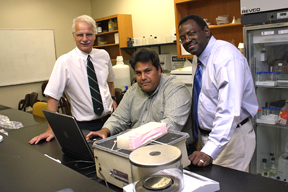Michael Wyss, Ph.D., and Tino Unlap, Ph.D., have spent the better part of the past decade reaching into under-served areas of the Birmingham community to give children an opportunity to learn.
 |
| UAB professors Michael Wyss, Ph.D., Tino Unlap, Ph.D., and Jesse Hipps, president of the Heritage Center for Human and Community Development, have combined forces to form BioTek Works — a new program designed to provide skilled workers for the regional biotechnology and biomedical industries. |
The UAB professors have partnered with Jesse Hipps, president of the Heritage Center for Human and Community Development, many times during those years on multiple collaborations through UAB’s Center for Community Outreach and Development (CORD).
Their latest endeavor, however, is their most ambitious yet.
BioTek Works is a new program designed by Hipps and Unlap to provide skilled workers for the regional biotechnology and biomedical industries. The first 14-week training program will commence this fall with instruction taking place in UAB’s CORD laboratories in the Community Health Services Building.
“The future of this area is not in blue-collar jobs. It’s in science,” says Wyss, a cell biologist who directs CORD. “Technological and scientific development are what drive the country, and if this area is going to build up it’s going to be because of science and technology.”
Many of the students being targeted for the BioTek program are high-school graduates who either don’t have the financial means or desire to immediately enroll in college. Their career ambitions largely are blue collar, and they’re often looking at minimum-wage jobs. This program will give them an opportunity to earn a certificate as a research assistant in slightly more than three months. After that, they then almost immediately could find industry research assistant jobs starting at around $10.50-$12.50 an hour. And that training will put them on a career path that can raise their standard of living even higher, not to mention attract many of them to advanced training at area schools, including UAB.
“Blue-collar and minimum-wage jobs don’t pay enough to raise families out of poverty level,” Wyss says. “We hope to get some of these kids from high school and move them into real career pathways. We hope these individuals become models for financially stable, established families and also serve as ambassadors for science and technology.”
The program initially is being funded by the Jefferson County Workforce Investment Board, which has provided $165,000 for the first classroom and on-the-job training. The long-term goal is for the program to be funded by local industry looking for certified research assistants.
Research assistants in demand throughout state
Researchers at UAB always are looking for research technicians. Finding, training and retaining them is a constant struggle, Unlap says, and the turnover rate can be maddening. “Many of the research assistants at UAB come in with a bachelor’s degree and are going on to medical or graduate school,” he says. “It takes six months to train someone in the lab. Then you may keep them for only one or two years and they’re gone.”
Hipps says local industry faces some of the same problems. And, he says, the lack of certified, ready-to-work research technicians hurts some of local businesses and also is costing the state of Alabama opportunities to entice companies to bring their well-paid research jobs to the area.
“Industry leaders are quick to point out that national and international biotech companies are looking at our state with keen interest in its scientific assets, but find some major weakness in our workforce capacity,” Hipps says. “Unless we can meet the demand for high-skilled workers, the biotechnology industry in Alabama is unlikely to grow beyond its current size or lose its gains due to industry attrition.”
Birmingham is quickly gaining a critical mass of biotechnology companies. According to the Biotechnology Association of Alabama, Birmingham is home to more than 70 bioscience companies. Boyd Company, a national consulting firm, also recently named Birmingham one of the most attractive cities in the world for biotechnology companies to locate — largely because of UAB.
Barbara White, project director for Work-force and Development, says it’s not just industries that could benefit from the BioTek Works training program. UAB stands to gain, as well.
“I’m looking at the current and future workforce needs, both staffing and competencies, and there is a definite need, especially knowing the research division at UAB will be expanding,” she says. “We want to develop a trained workforce that can support the incoming personnel.”
Classroom, lab training
Unlap will teach the first group of students this fall, using the book he authored, Basic Biotechniques: A Training Manual for Research Assistants. Classroom work is in the morning Monday through Friday and consists of 45-minute lectures on scientific principles, followed by practical application of principles through three hours of experimentation. Students will go to a laboratory on campus for hands-on training in the afternoon.
UAB also is working closely with Lawson State Community College, Jefferson State Community College, Bevill State Community College, the Biotechnology Association of Alabama, Bessemer City Schools and Alabama Industrial Development Training on this project. All involved hope those individuals who join the class eventually will go to college, either starting at one of the community colleges before transferring to UAB or beginning their collegiate careers here on campus.
The program also will target displaced workers, particularly those skilled in math and English.
Anyone interested in applying to be a part of the program should contact Hipps at the Heritage Center for Human and Community Development at 365-2280.
“UAB is a juggernaut in biotechnology, and now it’s going to lay the foundation for developing the workforce,” Hipps says. “UAB is literally blazing the trail that will help our state be very competitive in attracting industries to locate their companies in the Birmingham area and in reaching out into our own community to provide that workforce.”